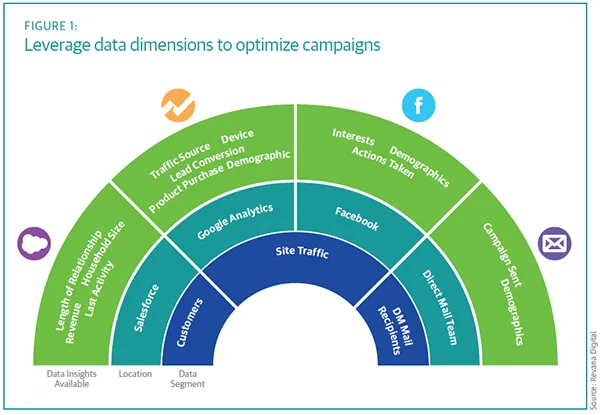The rise of Big Data and its effect on business innovation is undeniable: The increasing use of data is set to revolutionise business. But the need for data insights is outpacing the rate at which marketers are able to put their data into action.
This inability to convert data into insights can cripple marketers’ engagement efforts and leave companies falling behind their competition. Obtaining, analysing, and acting on accurate customer data and engaging with customers when, where, and how they want is critical for keeping pace with the changing needs and demands of customers.
Many marketers simply need a framework to derive actionable insights to kick-start their data journeys and help them get on the road to becoming data-driven marketers. A hallmark of an outstanding analytical program is that it has appointed standard processes and procedures in place for data gathering processes, specific measures for evaluating the data, and selection criteria for new tools and technologies that will help extract, analyse, and help put data into action.
Here are three steps that every marketer needs to take to create that framework and kick-start their data journeys.
Step 1: The Ask
Consumers are using numerous sources to arrive at purchase decisions. Those touchpoints are defined by many variables (channel choice, location, purchase time, etc.). All of these variables affect the journey’s evolution and how decisions are made, so deciphering these variables really makes it challenging to wrangle customer data and turn it into action.
It’s essential, therefore, for marketers to ask questions about their company’s data before embarking on an analytics project. Some qualifying questions could include:
• What are we trying to ask our data?
• What do we want from our data to allow us to achieve our goals?
• What are the KPIs that will help determine if we’re reaching our goals?
• Is there something that differentiates one segment of the audience from another?
• Are there unique attributes that our converting or desired audiences share?
Asking such questions will help to identify and prioritise profitable segments.
After marketers agree on the questions, a root cause analysis will help gauge, for example, the success or failure of a project or campaign, identify the cause of traffic increases to the site, predict future trends, etc. Root cause analysis is a technique used to help people answer the question of why the problem occurred in the first place.
When applied with rigor, root cause analysis will effectively identify probable causes of data issues. By drilling into details of a problem and talking to the right people, marketers will be able to successfully isolate probable causes that contribute to variables affecting specific customers, the business, or organisational issues.
Step 2: The Assets
After marketers answer the necessary questions at the onset of their data journeys, they then must decide what data they’ll collect and determine the scope of the data collection.
Because organisations need to invest in the right kinds of data (internal, external, structured, and unstructured), it’s important to consider the type of necessary information up front, agree on a common set of definitions, and pinpoint the available resources such as data collection tools, staff, and budgets.
Organisations have voluminous amounts of data across their departments and throughout their customers’ journeys, so it’s important to first define and organise the data assets into a data library. If marketers lack a clear awareness of what data exists, they should connect with different departments to learn more. Meet with finance, marketing, sales, etc. and engage in discovery conversations with those departments about what they’re learning on a daily basis.
Those insights will help to determine the data dimensions needed to optimise specific segments. Three effective dimensions include data location, data segment, and data insights to evaluate opportunities (see Figure 1). For example, within Google Analytics (location) a marketer may determine who is taking the desired actions (segment), if they align with the company’s objectives, and what he can learn from them (insights).
Step 3: The Levers
After the objectives are defined and the insights are uncovered, the next step is to make the necessary data-driven decisions. Understanding which levers correspond to specific business enablers will help marketers optimise their data strategies.
For example, a lever for a media optimisation specialist in the direct response environment might be how much to invest in targeted communications, while a professional on the brand voice side of marketing may need to know the types of messaging to send to customers and prospects throughout their purchasing journeys. For a B2B marketer, key levers might be strategic pricing and vendor management.
Defining the right set of levers for a marketer’s business and aligning them to enablers is a critical step in a data journey. Robust customer segmentation may enable or improve pricing and salesforce targeting, while having a better understanding of customer lifetime value will help enable targeted investments in customer journey messaging.

For a recent client, we visualised data from Google Analytics and determined three main levers: the device used, whether the user was a returning or new visitor, and from which media channel they derived. We determined these segments had a lower conversion rate. From that we were able to recommend site optimisation tactics and bump up conversion rates.
We also helped a storage company integrate Google Analytics with its CRM data. We analysed who was reserving storage units and staying in them for a long time. We wanted to know the attributes that would drive a statistically different lifetime value. What we found is that certain devices, age segments, and keywords were affecting the lifetime value of the storage unit user. If the user conducted a search using keywords around ‘temperature control storage,’ he was more likely to be a business user and therefore needed the storage unit for long-term use. From that data we were able to change the media mix based on those dimensions and increase the amount of traffic coming in toward a higher lifetime value segment.
When well-defined and aligned, levers and their enablers can form an integrated strategy that marketers can use to create strategic plans to benefit their departments, their enterprises, and ultimately their customers.
















